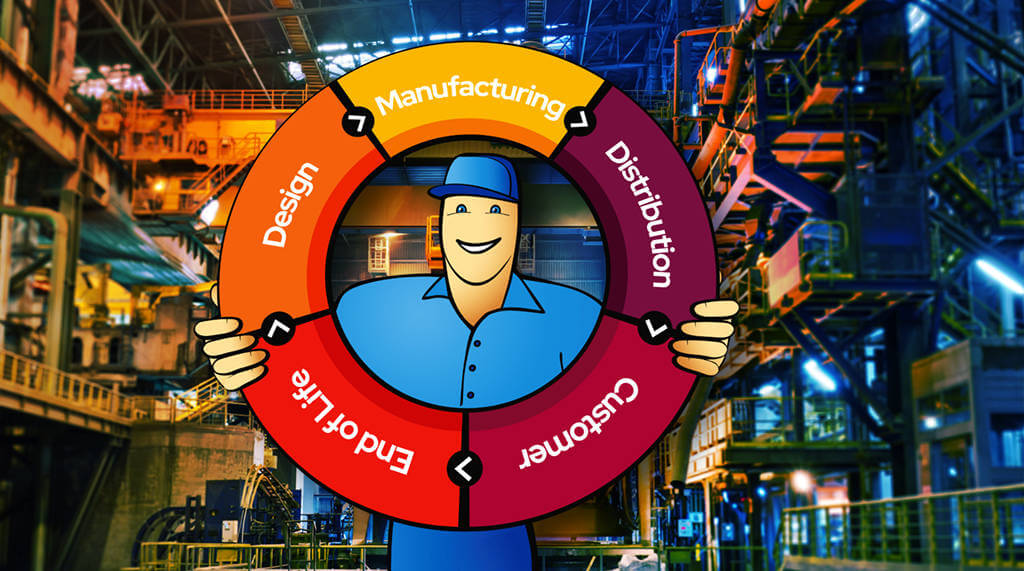What Is Product Lifecycle Management (PLM)?
Product Lifecycle Management (PLM) is the process of managing a product throughout its lifespan, from concept to manufacturing to disposal. Using PLM or MRP software to manage their products could bring manufacturers benefits ranging from better collaboration to optimized production processes and higher product quality.

You can also listen to this article:
What is Product Lifecycle Management (PLM)?
Product Lifecycle Management (PLM) is the process of managing a product throughout its lifecycle, from conceptualizing and designing to manufacturing and distributing to the servicing, repair, and disposal of the product. Controlling each stage of a product’s life allows companies to fine-tune various parts of the larger process and ensure that the product evolves in a desirable way.
The basis of product lifecycle management is the collection and organization of data related to the product and its associated activities. This enables companies to find and analyze any piece of information pertaining to the product, including the bills of materials and their different versions, analysis results, test specifications, quality standards and inspection results, production workflow specifications, material suppliers, sales metrics, servicing case reviews, etc. In addition to manufacturing, PLM is heavily used in software development.
The term “product lifecycle management” is also used in marketing and sales, albeit with a slightly different meaning. In this context, PLM means managing the marketing and sales efforts starting from the introduction of a new product, going through the product’s market growth and maturity stages, and ending with its market decline and discontinuation.
Another similar concept is product data management (PDM), which can be considered a precursor to PLM. While PDM is concerned only with the collection and organization of a company’s product data, PLM integrates the company further, allowing for workflow management, project management, change management, and a high degree of interdepartmental collaboration.
Stages of a product’s life cycle
A product’s lifecycle progresses from its inception to its manufacture and distribution until its eventual disposal. Here are the key stages a typical manufactured product goes through:
- Conceptualization. The first step in a product’s lifecycle is ideation. This involves generating the initial ideas, conducting market research, and matching the product to customer needs.
- Product design. In this stage, the product is engineered and developed. This product development process also includes specifying how the product will be manufactured as well as creating prototypes and testing them to make sure the product meets all the required criteria. Often, computer-aided design (CAD) is used in this stage.
- Manufacturing. When the product has been deemed market-ready, it is time to start the actual production. This includes setting up the manufacturing process, building production lines, sourcing raw materials, demand planning, determining material and capacity requirements, managing inventory, conducting quality inspections, procurement planning, packaging, etc.
- Distribution, sales, and marketing. This stage consists of setting up the logistics for distributing the product, creating strategies for pricing, sales, and marketing, and implementing the strategies. Forging distribution partnerships, determining your ideal customer and the best way to sell the product, doing product launches, creating awareness, conducting marketing campaigns, maintaining a presence on social media, etc. – all this is to ensure a successful product.
- Service and support. The after-sales stage includes providing customer support for the users of the product as well as services such as installation, repairs, and upgrades. This part also includes dealing with warranty cases and product returns and collecting customer feedback for improving the product or the associated services.
- Disposal and retirement. The last stage deals with the end-of-life of the product in two senses. First, how should the user dispose of the product? Can it be recycled or repurposed? Second, from the manufacturer’s perspective, when should the product be discontinued? Should there be another iteration? As all the product data is documented within a PLM system, creating a new and better version of the product can be done with minimal disruption.
Be mindful that although the aforementioned stages are presented in a linear way, a product’s lifecycle is never linear, with many of the stages taking place concurrently or running in a different sequence. For example, the product could go back into the design stage once a certain amount of customer feedback has been gathered that would allow the company to optimize the product for a better user experience. Another example would be to start marketing the product before actually building it, earning revenue from pre-sales to support the design and manufacturing stages.
Product lifecycle management with PLM software
Although the PLM process can be covered manually or semi-manually by using spreadsheets or various separate software solutions, it is very labor-intensive. Modern PLM software, however, automates a bulk of the processes involved and provides a much clearer view into your products and their performance thanks to integrating various parts of the business.
Benefits of PLM software for manufacturers
In addition to the better organization of their product data, manufacturers can gain many benefits from implementing product lifecycle management. These include:
- Improved communication and collaboration. Having all of your product information readily available to each stakeholder and employee dealing with various aspects of the product, be it R&D, production planning, or supply chain management, significantly improves communication and collaboration across the business.
- Streamlined product development. Using a cloud-based PLM solution gives a boost to product development by providing a real-time overview of all development suggestions, engineering changes, test results, etc. This allows companies to expedite product development and reduce the time-to-market of their products.
- Increased efficiency and reduced costs. Facilitating research and development, increasing the effectiveness of supply chain collaboration, and standardizing business processes across the company invariably lead to increased efficiency and reduced operational costs.
- Enhanced product quality. Setting up concrete product quality specifications and benchmarks and making the information readily available for QA personnel can significantly improve the quality control process. Tracking the results of quality inspections, on the other hand, allows you to detect systemic issues and resolve them, bringing the overall product quality up.
- Compliance and traceability. Within industries with strict regulations governing the manufacture of engineered products, ensuring traceability in product development and engineering is essential. A PLM system records all events within the journey from an idea to a product, providing regulators with a clear record of compliance.
- Better decision-making. PLM systems allow manufacturing companies to track the performance of a product from concept to retirement. This enables them to identify market trends, systematically analyze customer feedback, and improve their products as well as their ideation and design processes.
In many cases, these benefits are enough to provide a strong competitive advantage over other manufacturers who have yet to streamline their product management processes.
PLM software vs. ERP software
ERP (Enterprise Resource Planning) and its manufacturing counterpart MRP (Manufacturing Resource Planning, also known as manufacturing ERP) is a type of software used to manage the processes of a company as a whole. The software is designed to integrate all the departments and facilitate the sharing and continuous updating of business information across the value chain.
For example, when a critical quantity of finished goods is marked as sold, inventory levels are automatically updated, low stock alerts are disseminated, and new manufacturing orders and purchase orders are automatically pre-populated with the necessary information to be sent out as quickly as possible. New manufacturing orders are then automatically scheduled according to the production deadline or when resources are available, and the personal schedules of production workers are updated. This automated manufacturing management flow is something a PLM system is not specifically designed to do.
Although product lifecycle management and enterprise resource planning are essentially different concepts, PLM and ERP systems do exhibit a considerable overlap in terms of functionality. And that is why an ERP system is often sufficient or at least a good start for managing product lifecycles in a small manufacturing company. In any case, a manufacturing ERP system should be one of the first management software solutions introduced within any manufacturing business.
PLM functionality in manufacturing ERP
Apart from the game-changing manufacturing management functionality manufacturing ERP systems provide, including production planning, customer relationship management (CRM), inventory management, procurement, HR, and finances, some ERP systems also include some PLM tools. Taking MRPeasy manufacturing ERP software as an example, here is a list of PLM functionalities also present in manufacturing ERP systems:
- BOM management. Manufacturing ERP systems revolve around the bill of materials, which along with the correlating production routing is essentially the recipe for the product. Many systems also have integrations with CAD programs for seamless importing of product data but only the best solutions support multi-level BOMs and BOMs with parameters. MRPeasy also has a BOM version control functionality for tracking engineering changes or changes to recipes along with some other document management capabilities.
- Supply chain management. ERP systems also have procurement modules used for managing supplier data, including prices, supplier performance, quality rates, and invoices. Linked with the sales, production planning, and inventory management departments, this module provides purchasing employees with an accurate real-time overview of critical inventory levels and future demand forecasts.
- Quality management. A manufacturing ERP system can be used to record quality inspection results and track the performance of specific items, suppliers, production workers, or pieces of equipment. This is useful for detecting and resolving systemic issues that cause defects or low quality and ensuring that only high-quality products reach your customers.
- Product portfolio management. ERP systems can easily be used to store information pertaining to your products and to track their performance metrics, allowing you to decide when to discontinue or redesign a product.
- Returns management. Some manufacturing ERP systems also boast a return merchandise authorization (RMA) module. This is used to manage and track customer returns, their causes and required actions, warranty claims, repairs, etc.
A manufacturing ERP system such as MRPeasy is therefore a good first step towards having a clearer overview of your products and their performance, not to mention the expert manufacturing management tools it provides. This solution is especially good for businesses on a budget as PLM, ERP, and other business management systems often have exorbitant price tags while MRPeasy starts from only $49/month.
Key takeaways
- Product Lifecycle Management (PLM) is the process of managing a product throughout its lifecycle, from conceptualizing to manufacturing to the disposal of the product.
- The basis of product lifecycle management is the collection and organization of data related to the product and its associated activities.
- A product lifecycle can be divided into the following stages: conceptualization, design, manufacture, distribution, service, and disposal.
- Using PLM software enables companies to improve communication and collaboration, increase production and supply chain efficiency, enhance product quality, make better-informed decisions, and achieve traceability.
- A lot of what is possible with PLM software can also be achieved with a manufacturing ERP system.
Frequently asked questions
Product Lifecycle Management (PLM) is a term used to describe the process of managing the development, manufacture, distribution, and disposal – i.e., the whole life cycle – of a product.
A product’s life cycle includes the following stages:
1. Conceptualization
2. Design
3. Manufacture
4. Distribution
5. Service
6. Disposal
In marketing, a product’s life cycle consists of the following stages:
1. Introduction
2. Growth
3. Maturity
4. Decline
You may also like: Manufacturing Supply Chain Management – Best Practices for SMEs




